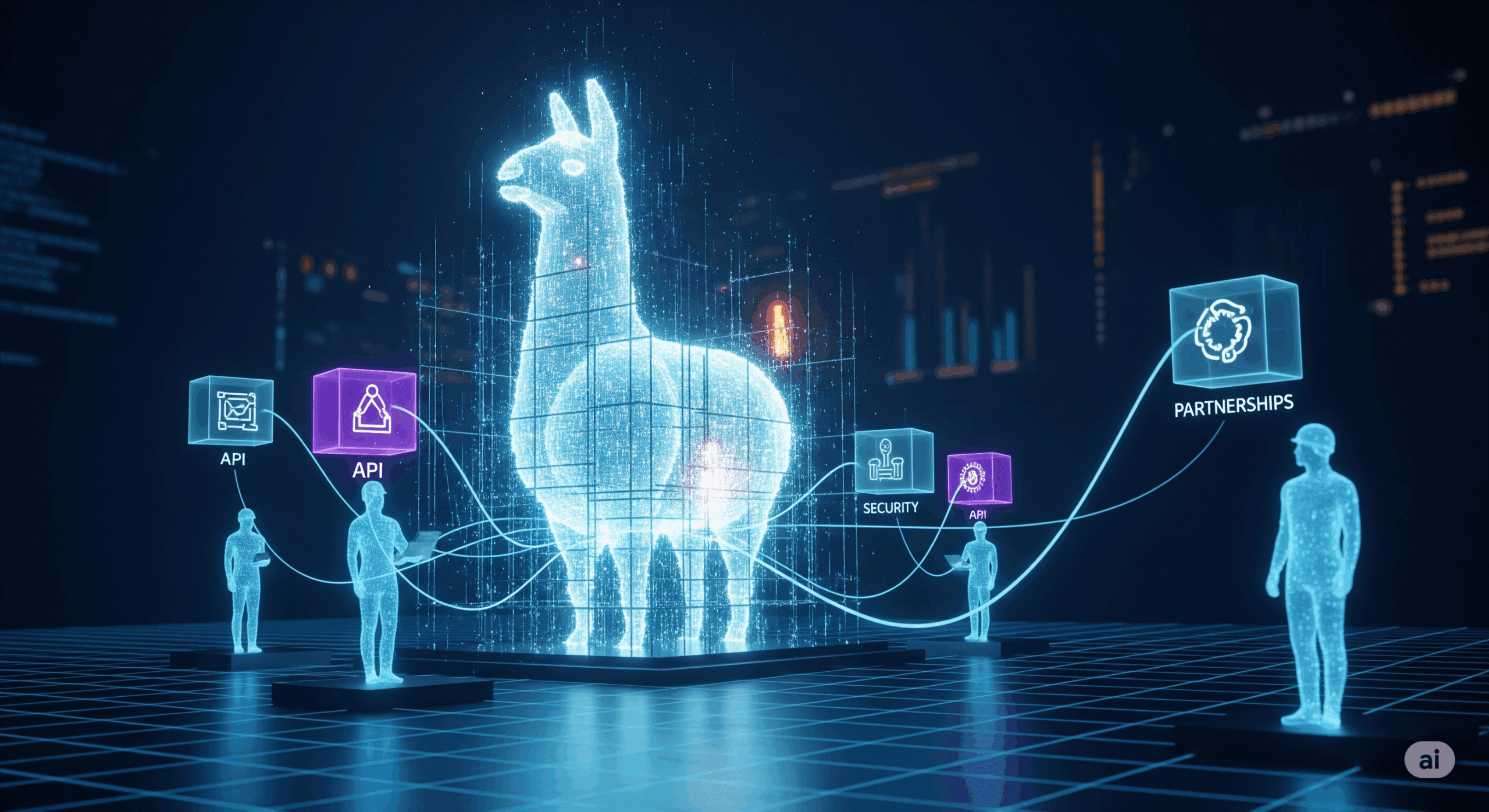Podcast: LlamaCon 2025_ Meta’s Strategic AI Empire and the Open-Source Gambit
The Dawn of the Llama-verse: A Strategic Pivot from Models to Ecosystem
On April 29, 2025, the artificial intelligence community turned its attention to Menlo Park, California, where Meta hosted its inaugural LlamaCon.1 By dedicating a standalone conference to its Llama family of large language models (LLMs), separate from its traditional Connect event, Meta signaled a pivotal maturation of its AI efforts.3 This was not merely a product showcase; it was a strategic declaration. The event’s agenda, heavily weighted toward developer tools, security frameworks, and high-profile partnerships, made one thing clear: Meta is no longer just competing in the race to build the most powerful model. It is now in the business of building an empire—a comprehensive, open-source ecosystem designed to be the foundational layer for the next generation of AI development.
For many in the open-source community, particularly on forums like Reddit’s r/LocalLLaMA, the conference was initially framed by an unmet expectation: the announcement of a new, state-of-the-art reasoning model to rival offerings from OpenAI or the surprisingly potent models from Chinese competitor DeepSeek.1 When the keynote concluded without the unveiling of the rumored “Behemoth” or a new reasoning-focused model, the immediate sentiment was one of disappointment.8 However, viewing the event through a strategic lens reveals that this omission was not an oversight but a deliberate choice. LlamaCon 2025 represented a calculated pivot away from the volatile, high-stakes game of benchmark supremacy and toward the more enduring goal of platform dominance.
The AI industry has been locked in a relentless and costly arms race, where leadership is often measured in single-digit percentage point gains on academic benchmarks—a position that can be lost in a matter of weeks. Meta itself experienced the precariousness of this competition with the release of its Llama 4 models just weeks before the conference. While technologically advanced, the models received a mixed reception from developers, particularly in the critical domain of coding, where they were seen as underperforming against more specialized open-source alternatives.9 To have centered LlamaCon around another model release would have invited direct, and potentially unfavorable, comparisons, risking the narrative of the entire event.
Instead, Meta chose to redefine the terms of engagement. The core message of LlamaCon was not about a single model’s superiority but about the collective power of an integrated ecosystem. By focusing on developer enablement through the new Llama API, ensuring enterprise readiness with a suite of security tools, and demonstrating market traction through partnerships with hardware and software giants, Meta is constructing a competitive moat.12 This strategy aims to make Llama the default, “sticky” platform for open-source AI. If successful, future Llama models will launch into a mature, supportive ecosystem with a massive, locked-in user base—an advantage far more durable than a temporary lead on a leaderboard.
The Developer’s Toolkit: Forging an Open-Source AI Platform
The substance of LlamaCon 2025 was delivered through a series of announcements, each a carefully placed brick in the foundation of Meta’s burgeoning AI ecosystem. The new offerings were meticulously designed to address the primary friction points of open-source AI development—complexity, security, and performance—while amplifying its core benefits of control and customization.
The Llama API: Bridging Open Flexibility with Closed Convenience
The centerpiece of the developer-focused announcements was the limited preview of the new Llama API.12 Billed as a way to “start using Llama with just one line of code,” the platform is engineered to drastically lower the barrier to entry for building on Meta’s models.13 It includes features common to proprietary offerings, such as one-click API key creation and interactive playgrounds for rapid prototyping with the new Llama 4 Scout and Maverick models.14
The most strategically significant feature of the Llama API is its direct compatibility with the OpenAI SDK.13 This is a clear and aggressive move to poach developers from the dominant closed-source ecosystem. By allowing engineers to switch from an OpenAI model to a Llama model simply by changing a URL, Meta has minimized the switching costs and technical hurdles that often lock developers into a single platform.
Furthermore, the API goes beyond simple inference. It provides integrated tools for fine-tuning and evaluation, starting with the Llama 3.3 8B model.12 This empowers developers to create custom, specialized models for their unique use cases with greater ease and efficiency. This combination of convenience and control is Meta’s answer to the central dilemma of the AI market: it offers the plug-and-play experience of a closed API while preserving the fundamental open-source promise of portability and ownership.
Meta AI Goes Standalone: A Trojan Horse for Mass Adoption
On the consumer front, Meta announced a standalone Meta AI application, effectively converting the existing Meta View app into a dedicated AI assistant.8 Powered by the new Llama 4 models, the app directly competes with ChatGPT and other mobile AI assistants, featuring a voice chat mode and a unique social “Discover” feed that showcases public prompts and interactions.16
While this move helps Meta achieve feature parity in the consumer AI space, its true strategic value lies in data acquisition.8 By allowing users to link their Facebook and Instagram accounts, the Meta AI app creates an unparalleled, real-time feedback loop. The billions of interactions, preferences, and social contexts flowing through Meta’s platforms can be leveraged to train and refine future Llama models, providing a proprietary data advantage that few competitors can match.16
Fortifying the Herd: Llama Protections for the Enterprise
A major historical advantage of closed-source models has been the perception of greater security and enterprise-readiness. LlamaCon saw Meta directly confront this issue with the launch of a new suite of Llama Protection Tools, including Llama Guard 4, LlamaFirewall, and Llama Prompt Guard 2.7 These tools are designed to help developers build robust safeguards into their applications, mitigating risks from harmful content and malicious prompts.
To bolster these efforts, Meta also announced the Llama Defenders Program, a collaboration with select partners to use AI-enabled tools to evaluate and enhance system security.12 This initiative serves a dual purpose: it improves the security of the Llama ecosystem while also signaling to risk-averse enterprise customers that Meta is treating the safety and security of its open-source offerings as a first-order priority.
Strength in Numbers: The Power of Partnership
Rounding out its ecosystem strategy, Meta showcased a series of key partnerships. To address performance bottlenecks, a known challenge for self-hosted models, Meta announced collaborations with specialized AI hardware companies Cerebras and Groq. These partnerships will provide developers with access to faster inference speeds for Llama 4 models directly through the Llama API, combining the accessibility of a managed service with the performance of purpose-built hardware.12
For enterprise deployment, Meta is expanding its Llama Stack integrations with industry giants like NVIDIA, IBM, Red Hat, and Dell Technologies.12 These collaborations are designed to make it easier for large organizations to deploy and manage Llama models within their existing IT infrastructure, a critical step for driving widespread corporate adoption.
| Announcement Category | Feature/Product | Key Details | Strategic Significance for Developers |
| Developer Tools | Llama API (Preview) | One-click API keys, interactive playgrounds, Python/TS SDKs, fine-tuning and evaluation tools. OpenAI SDK compatible. | Lowers barrier to entry, simplifies migration from closed models, and provides tools for creating custom, portable models.12 |
| Platform | Meta AI Standalone App | Converted from Meta View app, powered by Llama 4. Features a social “Discover” feed and voice chat. | Provides a direct consumer-facing competitor to ChatGPT and creates a massive data feedback loop for model improvement.8 |
| Security | Llama Protection Tools | Llama Guard 4, LlamaFirewall, Prompt Guard 2, and the Llama Defenders Program. | Addresses enterprise concerns about open-source security, making Llama a more viable option for production environments.12 |
| Hardware Partnerships | Cerebras & Groq Integration | Provides access to faster inference speeds for Llama 4 models directly through the Llama API. | Mitigates performance bottlenecks and offers developers a streamlined path for prototyping and scaling high-performance applications.12 |
| Enterprise Integrations | Llama Stack Expansion | Deeper integrations with NVIDIA NeMo, IBM, Red Hat, and Dell to simplify enterprise deployment. | Eases the adoption of Llama models within existing corporate IT infrastructure, making it a turnkey solution for large organizations.12 |
Fireside Wisdom: Zuckerberg, Nadella, and Ghodsi on the AI Revolution
The strategic messaging of LlamaCon was most clearly articulated during the high-profile fireside chats featuring Meta CEO Mark Zuckerberg in conversation with Databricks CEO Ali Ghodsi and Microsoft Chairman and CEO Satya Nadella. These were not merely celebrity appearances; they were carefully choreographed dialogues intended to frame Meta’s vision for AI and position the company as a central, collaborative force in the industry’s future.
The Open vs. Closed Debate: A New Synthesis
The discussion between Zuckerberg and Nadella was particularly revealing, signaling a potential realignment of the AI landscape. Zuckerberg opened with effusive praise, calling Microsoft the “greatest technology company,” while Nadella adopted a pragmatic stance on the open-versus-closed model debate, stating he was “not dogmatic about it” and that both approaches are necessary.4 This public display of camaraderie challenges the simplistic narrative of a binary conflict between Meta’s open ecosystem and Microsoft’s closed-source partner, OpenAI.
A more complex dynamic is emerging, one that suggests a strategic alliance. Microsoft, as a dominant cloud provider, stands to benefit immensely from a thriving open-source ecosystem that runs on its Azure infrastructure. By championing open-source, Meta establishes itself as the leader of this ecosystem, creating a powerful counterweight to Google’s vertically integrated, end-to-end AI stack. Nadella’s presence at LlamaCon lends significant enterprise credibility to Meta’s efforts.
The concept of “distillation factories,” which Nadella discussed, fits perfectly within this symbiotic framework.20 In this model, Meta can focus on its core competency: building massive, powerful, open-source foundation models like the forthcoming Behemoth. Enterprises can then leverage tools from partners like Microsoft and Databricks, running on cloud platforms like Azure, to distill these large models into smaller, cheaper, and highly specialized versions tailored to their specific needs. This creates a powerful division of labor: Meta provides the raw, open-source intelligence, while its partners provide the enterprise-grade tools and infrastructure to refine and deploy it.
The Rise of AI Agents: From Co-pilot to Co-worker
A recurring theme throughout the day’s discussions was the industry’s rapid pivot from generative AI to agentic AI.22 The conversation is no longer just about AI that can write an email or a block of code, but about autonomous agents that can reason, plan, and execute complex, multi-step tasks. Nadella revealed that AI is already generating 20-30% of the code within Microsoft, a figure Zuckerberg predicted would rise to 50% for Meta’s own development within the next year.21
This shift has profound implications. It reframes the future of software development and knowledge work, moving from a model of human-as-operator to human-as-orchestrator. As AI agents become capable of independently managing workflows, the role of human developers will increasingly focus on high-level system design and strategic oversight. This evolution from a simple co-pilot to a true digital co-worker represents a paradigm shift that current policy discussions, often fixated on chatbots, have yet to fully address.22
Open Source as a Geopolitical Strategy
The conversation with Databricks CEO Ali Ghodsi further cemented the strategic importance of Meta’s open-source push. Ghodsi highlighted compelling use cases, such as Crisis Text Line’s deployment of a customized Llama model to improve suicide risk assessment, demonstrating the societal benefits of accessible AI.22
Beyond these applications, there is a clear geopolitical dimension to Meta’s strategy. The rise of powerful open-source models from China, most notably from DeepSeek, has created a sense of urgency within the US tech community. Establishing a robust, US-led open-source ecosystem built around Llama is seen as a strategic imperative to ensure that American values and security considerations are embedded in the foundational models that will be adopted globally.22
The Herd in the Room: Llama 4 and the Community’s Mixed Reaction
While LlamaCon’s official agenda focused on the ecosystem, the performance of the Llama 4 models, announced just weeks prior on April 5, 2025, loomed large in the background.27 These models provided the essential context for Meta’s strategic pivot and fueled a vibrant, if at times critical, community response that highlighted a growing disconnect between the company’s enterprise ambitions and the expectations of its grassroots supporters.
Unpacking the Llama 4 Herd: Scout & Maverick
The Llama 4 family marked a significant architectural evolution, introducing a Mixture-of-Experts (MoE) design to the Llama lineage for the first time.27 This approach aims to deliver the knowledge capacity of a massive model with the computational cost and speed of a much smaller one by only activating a fraction of the model’s total parameters for any given task.29
The initial release featured two main variants:
- Llama 4 Scout: A 109-billion-parameter model with 16 experts, activating 17 billion parameters per token. Its standout feature is an industry-leading 10-million-token context window, designed for processing vast amounts of information in a single prompt.32
- Llama 4 Maverick: A much larger 400-billion-parameter model with 128 experts, which also activates 17 billion parameters per token. It was positioned as the higher-performance, general-purpose model with a 1-million-token context window.32
Both models are also natively multimodal, trained from the ground up to process both text and images using an “early fusion” technique that integrates visual and linguistic data at the earliest stages of processing.27
| Model | Total Parameters | Active Parameters | Number of Experts | Max Context Window | Primary Use Case |
| Llama 4 Scout | 109B | 17B | 16 | 10M tokens | Long-context tasks, document analysis, efficient deployment.33 |
| Llama 4 Maverick | 400B | 17B | 128 | 1M tokens | High-performance multimodal reasoning, chat, and creative tasks.33 |
The Developer Verdict: Underwhelming Performance and a Broken Lineage?
Despite the impressive on-paper specifications, the developer community’s reaction to Llama 4 was decidedly mixed. A recurring theme in online discussions was disappointment with the models’ coding capabilities. On benchmarks like AIDER, Llama 4 Maverick was shown to lag behind not only proprietary models but also smaller open-source competitors.11 Real-world feedback from developers echoed these results, with many finding the models less reliable for practical coding tasks compared to alternatives.9
Another significant point of criticism was the sheer size of the models. The smallest Llama 4 variant, Scout, with its 109 billion total parameters, is beyond the reach of most hobbyists and independent researchers to run on local hardware.11 This was seen by many as a betrayal of the “Local LLaMA” ethos that had defined the community. The Llama project rose to prominence because it empowered individuals to run powerful models on their own machines; the Llama 4 release, in contrast, seemed to cater primarily to enterprises with access to high-end server-grade GPUs. This sentiment of disappointment and a sense of a “broken lineage” was palpable across developer forums, underscoring the strategic necessity for Meta to shift the narrative at LlamaCon away from raw model performance and toward the accessibility and utility of its broader ecosystem.
Conclusion: Is Meta’s Open-Source Bet a Winning Hand?
LlamaCon 2025 may have been perceived as underwhelming by those anticipating the spectacle of a new state-of-the-art model, but to dismiss it as such is to miss the larger strategic game at play. The conference was a masterclass in corporate repositioning, marking Meta’s deliberate transition from a participant in the AI model arms race to the architect of the open-source AI economy.
The announcements of the Llama API, the standalone Meta AI app, robust security tools, and key industry partnerships were not disparate product updates; they were interconnected components of a cohesive platform strategy. By making it easier, safer, and more efficient for developers to build with Llama, Meta is constructing a powerful ecosystem designed to foster loyalty and create a competitive moat built on community and infrastructure, not just temporary benchmark leads.
This strategy plays directly to Meta’s unique strengths. Its massive social media platforms provide an unparalleled source of data and a built-in user base for its AI assistant. Its vast compute resources allow it to train foundation models at a scale few can match. And its advertising-based business model means it does not need to directly monetize its AI models, allowing it to aggressively undercut competitors on price and pursue an open-source strategy that would be untenable for others.
The ultimate success of this ambitious gambit rests on a simple premise: that the future of AI will be built, not just downloaded. It depends on whether the global developer community accepts Meta’s invitation, embraces its new toolkit, and chooses to build the next generation of AI applications on the Llama platform. LlamaCon 2025 was the formal opening of the gates; the question now is who will come to build within the walls.


